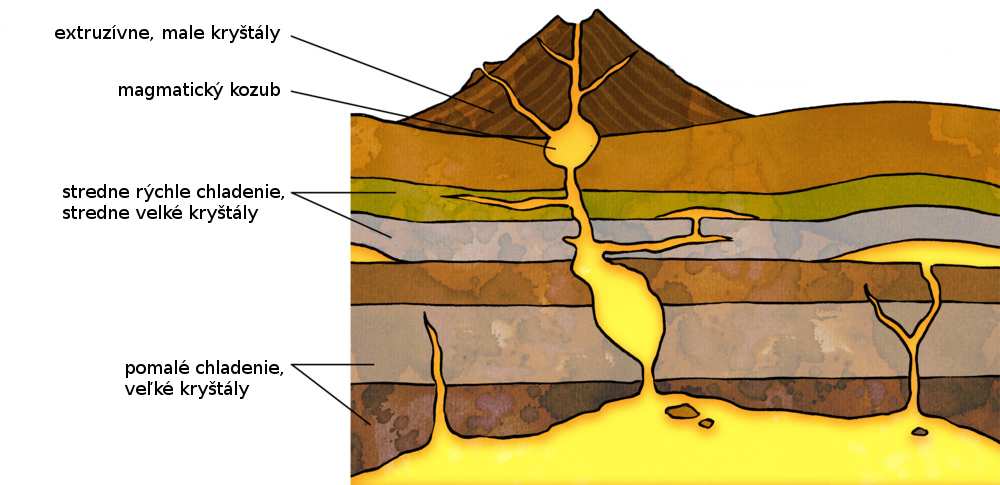GE: Sopečné horniny EarthCache
-
Difficulty:
-

-
Terrain:
-

Size:  (other)
(other)
Please note Use of geocaching.com services is subject to the terms and conditions
in our disclaimer.

Hodžovo námestie
Úvod
Raz pri prechádzke po centre mesta som si uvedomil, že všade okolo sa nachádzajú exponáty obrovskej geologickej zbierky. Pokusím sa prostrednístvom tejto Geologickej Exkurzie krátko, jednoducho a zrozumiteľne opísať zaujímavé miesta a priniesť nový pohľad na svet okolo.
Sopečné horniny na námestí
Pod vašimi nohami sa na námestí nachádza dlažba z čiernych bazaltových (čadičových) kociek pleistocénneho veku (pleistocén je obdobie pred cca 2.5 milionmi rokmi až 11 tisic rokmi) z okolia Fiľakova. Na hornej stene vchodu do podchodu môžete vidieť libereckú ružovú žulu. Jej ružovú farbu spôsobujú živce.
Vedeli ste, že obe horniny sú magmatick´ého pôvodu ?
Intruzívne a extruzívne
Mohlo by sa zdať, že vyvretá hornina vzniká iba na povrchu Zeme. Na obrázku dole je vysvetlené, kde tuhnutie vyvretých hornín prebieha. Rozoznávame dve hlavné skupiny vyvretých hornín:
Intruzívne - keď proces kryštalizácie magmy prebieha pod povrchom Zeme. Nazývajú sa aj hlbinné, alebo plutonické - podľa Pluta - rímskeho boha podzemia.
Extruzívne horniny - keď kryštalizácia lávy prebieha na povrchu. Nazývajú sa aj výlevné, alebo vulkanické - podľa Vulkána, rímskeho boha ohňa.
Proces chladenia horúcej magmy hlboko (10-20km) pod povrchom Zeme prebieha oveľa pomalšie ako chladenie lávy na povrchu. Pomalšie chladenie umožňuje vznik oveľa väčších kryštálov v intruzívnych horninách ako rýchle chladenie v extruzívnych horninách. Preto intruzívne horniny majú oveľa väčšie kryštály ako extruzívne horniny.
Magma a láva sú obe v podstate roztopené kamene s teplotou 600-1200°C, ale magmou sa nazýva to, čo je pod povrchom v zemskej kôre. Magma sa môže dostať na povrch erupciou a potom už hovoríme o láve.

Mačacie hlavy, ako sa občas volajú dlažobné kocky na ktorých stojíte, mali kedysi pred stovkami tisíc rokov teplotu asi 1100 °C a vytvárali ich lávové prúdy na povrchu Zeme (alebo vo veľmi malej hĺbke tesne pod povrchom). Žula nazývana aj granit, vzniká tuhnutím magmy vo veľkej hĺbke a tvorí významnú časť pevninskej zemskej kôry. Väčšina žúl sa vytvorila už v prekambriu, tj období pred prvohorami. A teda aj tá na obklade je zrejme stará viac ako 550 miliónov rokov.
Úlohy
Pred zalogovaním kešky musíte poslať správne odpovede na otázky. Odpovede zasielajte cez môj profil. Logovanie kešky robte prosím ihneď po zaslaní odpovedí. Logy bez zaslaných odpovedí budem mazať.
Návod na použitie v skratke: Posielam odpovede hneď potom logujem kešku.
Ak nesúhlasite s týmto pravidlom, tak prosím nelogujte túto earth kešku. Bližšie informácie o požiadavkách na logovanie earth cache nájdete tu http://www.geosociety.org/GSA/fieldexp/EarthCache/guidelines/home.aspx
1. Pozorovaním oboch spomenutých hornín odhadnite, ktorá z nich je extruzívna. Popíšte prečo.
2. Nepovinne - pridajte do logu fotku kryštálov, ak ste v hornine nejaké našli.

Hodžovo námestie
Introduction
One day while walking through the city center, I realized that all around there are exhibits of large geological collection. Through this Geological Excursion I will try to briefly, easily and comprehensively describe interesting places and bring a new look to the world around us.
Igneous rocks at the square
Under your feet there is a pavement of pleistocene black basalt cubes (Pleistocene is about 2.5 million years to 11 thousand years ago) from the Fiľakovo city area. On the upper wall of the underpass entrance you can see the Liberec pink granite. Its pink color causes feldspars.
Did you know that both rocks are of magmatic origin?
Intrusive and extrusive
It may seem that igneous rocks form only on the surface of the Earth. The picture below explains where the solidification can happen. We recognize the two main groups of igneous rocks:
Intrusive rocks are formed from magma that cools and solidifies within the crust of Earth. They are also called Plutonic - the term originated from Pluto, the classical god of the underworld.
Extrusive also known as volcanic rocks, are formed at the Earth surface from lava as a result of eruption of magma. The term volcanic originates form the Vulcan - god of fire in ancient Roman religion.
The process of hot magma solidifies and cooling deeply (10-20km) below the surface of the Earth takes much longer time than cooling the lava on the surface. A slower cooling allows formation of much larger crystals in intrusive rocks than rapid cooling lava on the Earth surface. Therefore intrusive rocks have much larger crystals than extrusive rocks.
Both magma and lava are essentially melted stones at a temperature of 600-1200°C, but the magma is called what is below the Earth surface - in the crust. Lava is magma that reaches the surface of our planet through a volcano vent.

Black basalt cobblestones that you are standing on the spot were hot around 1100°C and were created of lava flows on the Earth surface (or very shallow under the Earth surface). Granite is formed by solidification of magma at great depth and forms a significant part of the continental Earth's crust. Most of the granite was formed already in the Precambrian, that is the period before the Paleozoic era. And so the the wall cladding it probably over 550 million years old.
Tasks
Before you log the earth cache you have to send the correct answers to the questions. Reply via my profile. Logging the earth cache should be done right after sending the answers. I will delete the logs without answers.
Brief instructions for use: I send answers and then I log the earth cache.
If you do not agree to this requirement, please do not log this earth cache. For details about earth cache requirements see http://www.geosociety.org/GSA/fieldexp/EarthCache/guidelines/home.aspx
1. By observing the two mentioned rocks, guess which of them is extrusive. Describe why.
2. Optionally, add a photo of the crystals to your log, if you have found some in the rock.
Additional Hints
(No hints available.)